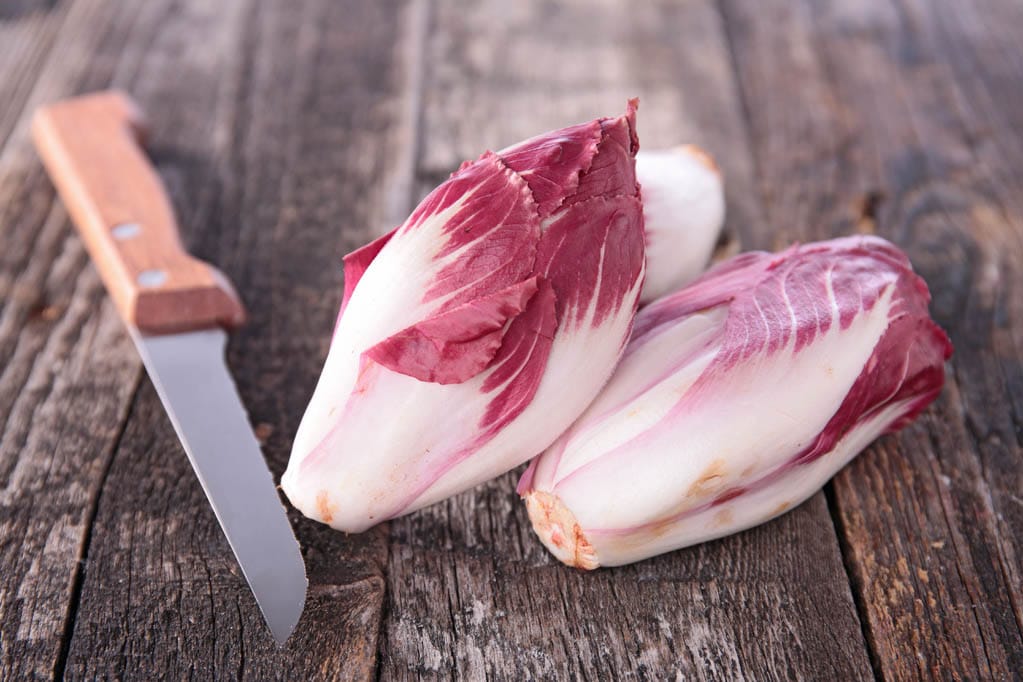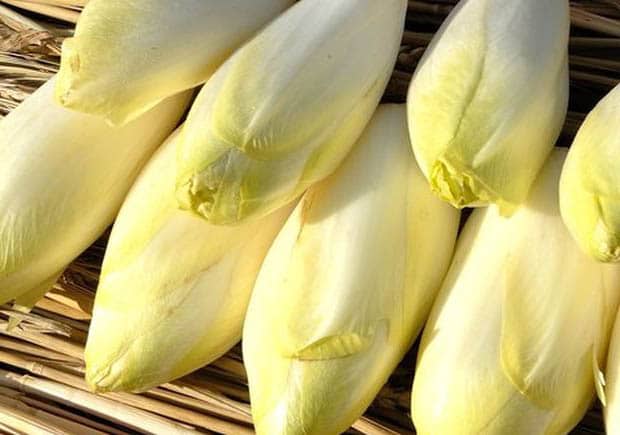When to sow chicory?
Endives are sown between May and June. It should be noted that this period may vary depending on the variety.
It is harvested in October, at which time the forcing will begin: deprived of light – and therefore photosynthesis – the endive will develop the white leaves very slightly hemmed with green or purple that make it special.
Which varieties to choose?

Endive is almost born by chance. It is indeed a chicory. Covered with earth, and thus deprived of light, it produces a white chicory, with grouped and compact leaves. It is therefore not strictly speaking a variety: it is exclusively obtained by forcing. And this is besides in the middle of 19th century that the particular flavor of this "missed chicory" was really discovered and appreciated.
In the vegetable garden, however, you have the choice between different varieties:
- Thewhite endive – sometimes called chicory, Witloof or chicory of Brussels – is widespread. She distinguishes herself to her rather bitter taste, which is why one sometimes avoids consuming one's heart;
- Thered endive (Endigia) owes its name to the red color that hems its leaves. From the cross of endive and red chicory, it has a softer flavor;
- The Carmine comes from the crossing of white endive with two varieties of chicory: Chioggia and Verona chicory.
Thewhite endive has the particularity of being tasted as raw as cooked. Red varieties offer a softer and more subtle flavor. On the other hand, they are consumed exclusively raw.
What to do before sowing chicory (preparation, etc.)?
The endive will appreciate a well amended soil. Work the soil with a fork for 30 cm, and incorporate a generous amount of compost and manure or compost ripe.
How to sow them?
The endive sits in place, in other words: directly in the garden. The sowing is pretty classic:
- Draw rows spaced 25 to 30 cm apart;
- Sow the seeds in line, using a seed drill;
- Cover and tamp lightly with the rake;
- Water in fine rain not to move the seeds.
For a more regular sowing, do not hesitate to mix the seeds with a little sand.
Wait until the plants have 3 to 4 leaves to lighten. Keep one plant every 30 cm. You dread the mess? Know that you can transplant the plants instead of eliminating them.
Where to plant chicory?
Endive requires a very sunny location. It will especially be enjoyed with radish, carrot, turnip or leek. However, avoid installing near artichoke, lettuce or Jerusalem artichoke.
How to maintain them?
In the garden, endive requires little maintenance: just hoe and eliminate weeds for it to grow properly. In the fall, on the other hand, the endives must be pulled out and forcing.
Tear off endives
Endives can be pulled out as early as October. To stagger the harvest, several tears are regularly removed until December.
- Use the fork spade, which will allow you to recover the plant and its roots;
- Select the best-developed plants (count 4 cm in the collar);
- Let the roots dry for 10 days, placing the plants in a shaded area.
Before forcing, prepare the seedlings by cutting the leaves 2 cm above the collar and cutting the roots in a bevel, 20 cm from the collar.
Forcing endives
It is possible to proceed with forcing in the garden:
- Make a trench at least 50 cm deep;
- Place the roots against each other, vertically, in a soft soil;
- Cover with soil (about 20 cm);
- Water
- Cover with a layer of straw (about 20 cm).
Most varieties, however, lend themselves to cellar forcing, which is often more practical.
- Prepare sealed boxes 20 to 30 cm high;
- Deposit cardboard at the bottom, to absorb the excess water;
- Arrange the roots against each other, vertically;
- Cover with potting soil;
- Place the boxes in a cool place (10 to 15 ° C) away from light.
How to water chicory?
In the kitchen garden, endive will appreciate a regular watering, but well dosed: no question of flooding the roots! If you opt for cellar forcing, it is important to ensure that the substrate is moist.
Harvest endives: when and how?

Endives can not be stored well: no more than a few days in the vegetable compartment of the refrigerator. They will be harvested as and when needed, to consume them in stride, 3 to 4 weeks after the start of forcing. Just break them down. Make sure to keep the roots: you will probably be able to make a second harvest. The endives are very productive: after a second harvest, they often produce small tender chicory, delicious in salad.
Endive diseases and what to do?
Endive does not fear the disease. On the other hand, she dreads two small invaders:
- The to gray : this noctuid larva, plump and up to 5 cm, is very difficult to eradicate. Regular hoeing can help, especially if you open the eye to harvest the larvae. The birds are fond of it, and if you put the larvae within reach, they will be happy to get rid of them. You can also opt for a biological treatment, by introducing nematodes, microscopic parasites that will be responsible for eliminating cutworms;
- The aphid Pemphigus Bursarius : as a precaution, avoid growing endive next to the poplar tree, on which it is happy to winter. To overcome this, the ideal is to rely on its natural predators, like the ladybug.
Even more plantations:









